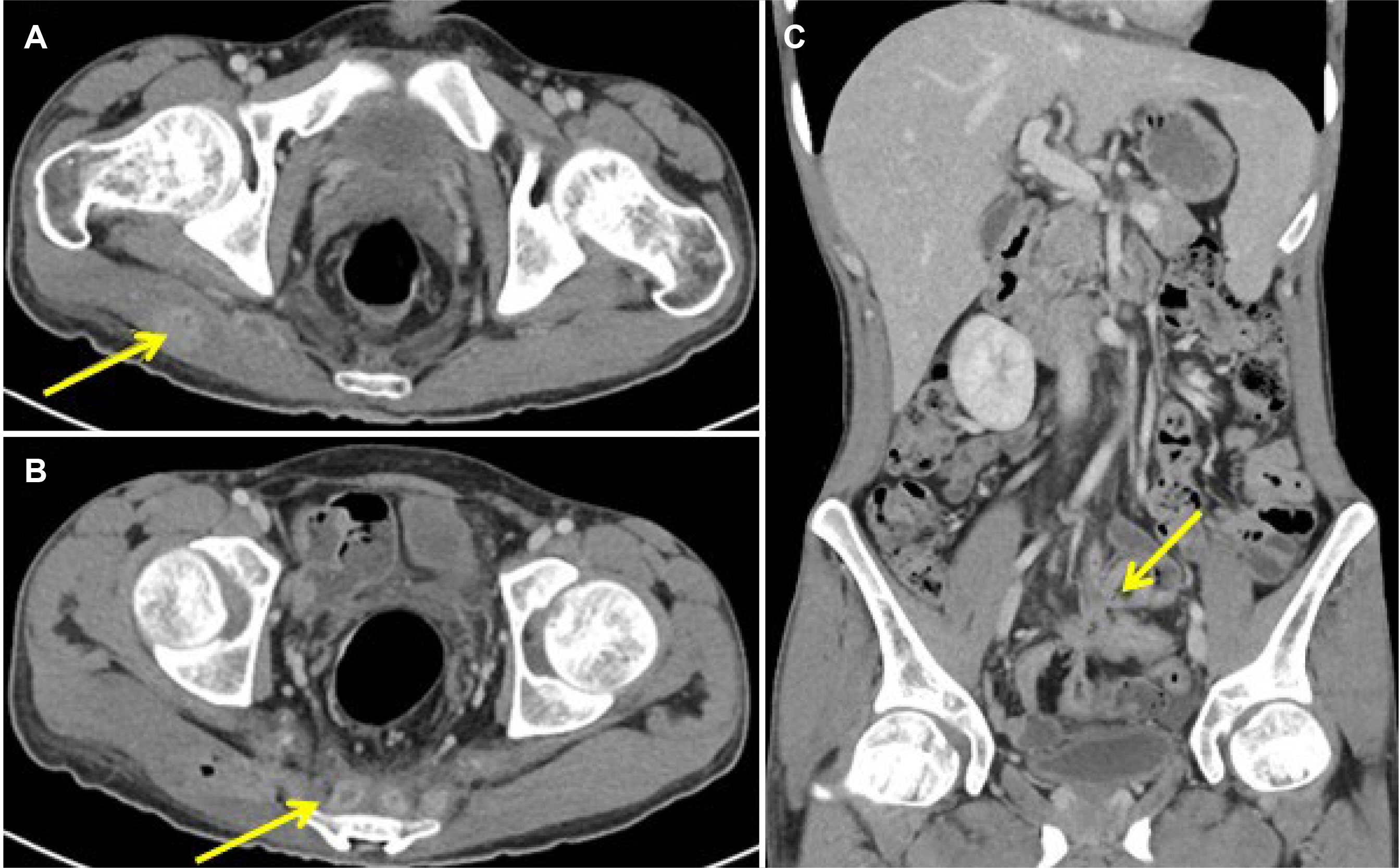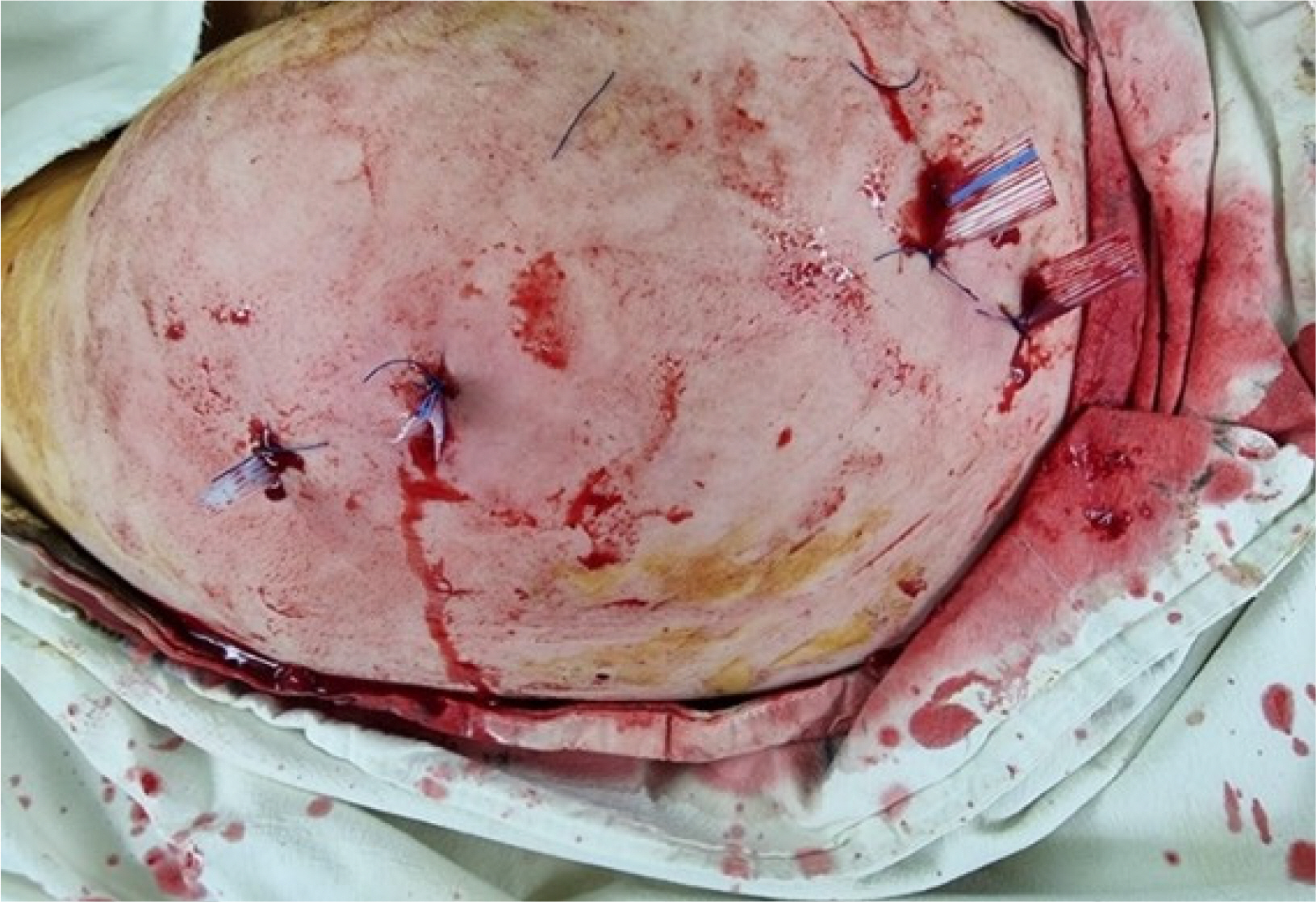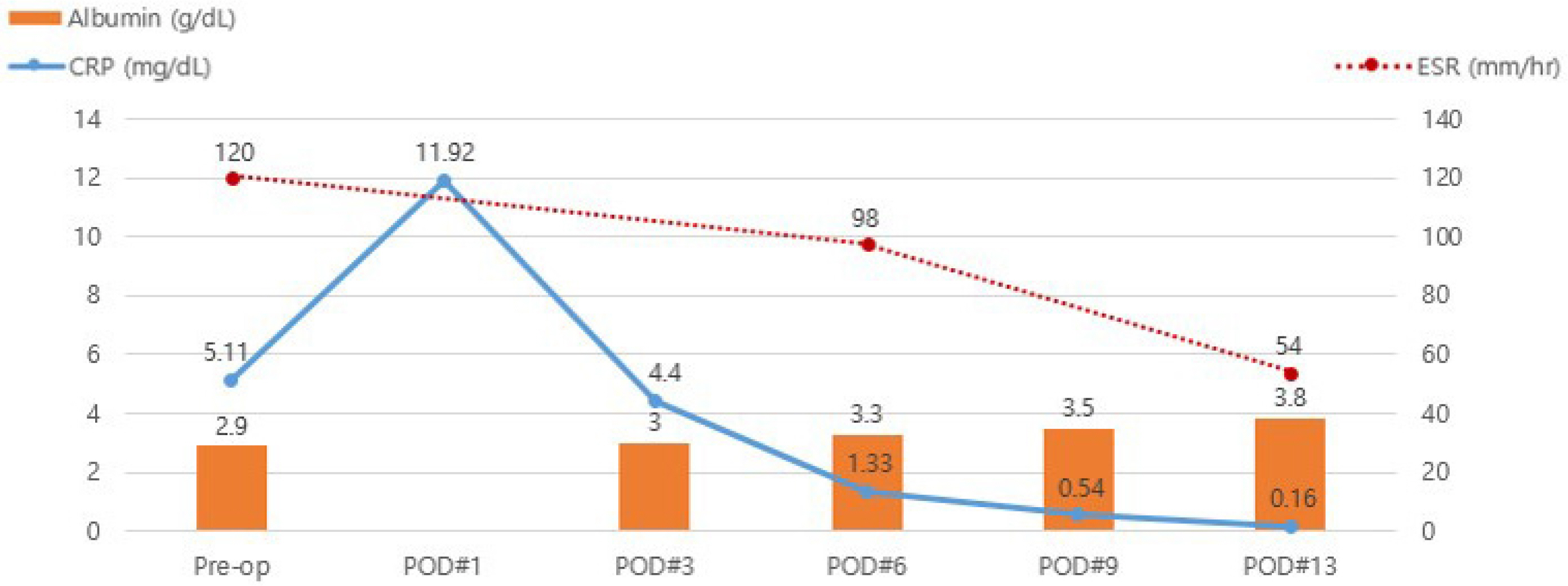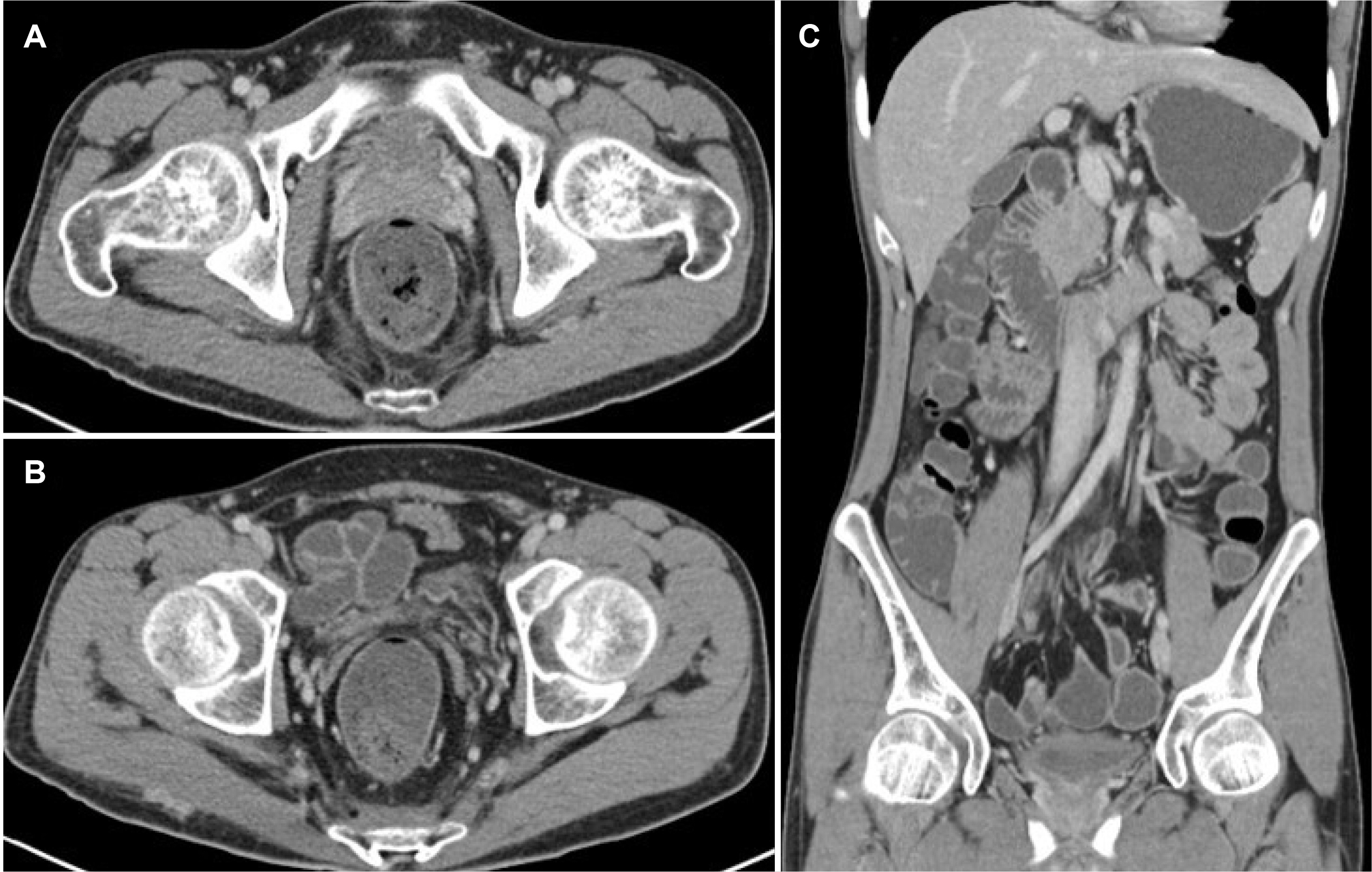Korean J Gastroenterol.
2022 Dec;80(6):267-272. 10.4166/kjg.2022.088.
Gluteal and Presacral Abscess Due to Crohn’s Disease with Multiple Fistulas
- Affiliations
-
- 1Departments of Internal Medicine, Jeju National University College of Medicine, Jeju, Korea
- 2Departments of Surgery, Jeju National University College of Medicine, Jeju, Korea
- KMID: 2537098
- DOI: http://doi.org/10.4166/kjg.2022.088
Abstract
- The abscess is a common complication of Crohn’s disease (CD), with the perianal form more frequent than gluteal or presacral which is relatively rare. There are few case reports of gluteal abscess combined with presacral abscess caused by CD and the treatment has not been established. A 21-year-old male was admitted with right buttock and lower back pain with a duration of 3 months. He had a history of CD in the small intestine diagnosed 10 months previously. He had poor compliance and had not returned for follow-up care during the previous 6 months. Abdominopelvic CT indicated newly developed multiple abscess pockets in right gluteal region, including piriformis muscle and presacral space. Additionally, fistula tracts between small bowel loops and presacral space were observed. Patient’s CD was moderate activity (273.12 on the Crohn’s Disease Activity Index [CDAI]). Treatment was started with piperacillin/tazobactam antibiotic but patient developed a fever and abscess extent was aggravated. Therefore, surgical incision and drainage was performed and 4 Penrose drains were inserted. Patient’s pain and fever were resolved following surgery. Infliximab was then administered for the remaining fistulas. After the induction regimen, multiple fistula tracts improved and patient went into remission (CDAI was -0.12).
Keyword
Figure
Reference
-
1. Torres J, Mehandru S, Colombel JF, Peyrin-Biroulet L. 2017; Crohn's disease. Lancet. 389:1741–1755. DOI: 10.1016/S0140-6736(16)31711-1. PMID: 27914655.
Article2. Pariente B, Cosnes J, Danese S, et al. 2011; Development of the Crohn's disease digestive damage score, the Lémann score. Inflamm Bowel Dis. 17:1415–1422. DOI: 10.1002/ibd.21506. PMID: 21560202. PMCID: PMC3116198.
Article3. Wang J, Ng M, Kochar K. 2019; Large presacral abscess in a patient with Crohn's disease. J Surg Case Rep. 2019:rjz297. DOI: 10.1093/jscr/rjz297. PMID: 31700604. PMCID: PMC6827548.
Article4. Baumgart DC, Sandborn WJ. 2012; Crohn's disease. Lancet. 380:1590–1605. DOI: 10.1016/S0140-6736(12)60026-9. PMID: 22914295.
Article5. Feuerstein JD, Cheifetz AS. 2017; Crohn disease: epidemiology, diagnosis, and management. Mayo Clin Proc. 92:1088–1103. DOI: 10.1016/j.mayocp.2017.04.010. PMID: 28601423.
Article6. Richards RJ. 2011; Management of abdominal and pelvic abscess in Crohn's disease. World J Gastrointest Endosc. 3:209–212. DOI: 10.4253/wjge.v3.i11.209. PMID: 22110836. PMCID: PMC3221952.
Article7. O'Malley BP, Minuk T, Castelli M. 1989; Buttock abscess complicating Crohn's disease. Can Assoc Radiol J. 40:51–52.8. Mayer DA, Zingale RG, Tsapogas MJ. 1993; Case study: Gluteal abscess due to Crohn's disease. Ostomy Wound Manage. 39:30–34.9. Denton ER, Jamieson CP, Rankin SC. 1996; Case report: abscess of the adductor muscles of the thigh--an unusual complication of Crohn's disease. Br J Radiol. 69:865–866. DOI: 10.1259/0007-1285-69-825-865. PMID: 8983593.
Article10. Hussien M, Mudd DG. 2001; Crohn's disease presenting as left gluteal abscess. Int J Clin Pract. 55:217–218.11. Tonolini M, Ravelli A, Campari A, Bianco R. 2011; Comprehensive MRI diagnosis of sacral osteomyelitis and multiple muscle abscesses as a rare complication of fistulizing Crohn's disease. J Crohns Colitis. 5:473–476. DOI: 10.1016/j.crohns.2011.04.009. PMID: 21939924.
Article12. Sangwan YP, Schoetz DJ Jr, Murray JJ, Roberts PL, Coller JA. 1996; Perianal Crohn's disease. Results of local surgical treatment. Dis Colon Rectum. 39:529–535. DOI: 10.1007/BF02058706. PMID: 8620803.13. Berkelhammer C, Debre M, Gutti P. 2005; Piriformis muscle abscess complicating Crohn's ileitis. Inflamm Bowel Dis. 11:1028–1029. DOI: 10.1097/01.MIB.0000186487.76364.c8. PMID: 16239852.
Article14. Brenner HI, Fishman EK, Harris ML, Bayless TM. 2000; Musculoskeletal complications of Crohn's disease: the role of computed tomography in diagnosis and patient management. Orthopedics. 23:1181–1185. DOI: 10.3928/0147-7447-20001101-17. PMID: 11103962.
Article15. Present DH, Rutgeerts P, Targan S, et al. 1999; Infliximab for the treatment of fistulas in patients with Crohn's disease. N Engl J Med. 340:1398–1405. DOI: 10.1056/NEJM199905063401804. PMID: 10228190.
Article16. Sands BE, Anderson FH, Bernstein CN, et al. 2004; Infliximab maintenance therapy for fistulizing Crohn's disease. N Engl J Med. 350:876–885. DOI: 10.1056/NEJMoa030815. PMID: 14985485.
Article17. Poggioli G, Laureti S, Campieri M, et al. 2007; Infliximab in the treatment of Crohn's disease. Ther Clin Risk Manag. 3:301–308. DOI: 10.2147/tcrm.2007.3.2.301. PMID: 18360638. PMCID: PMC1936311.
Article
- Full Text Links
- Actions
-
Cited
- CITED
-
- Close
- Share
- Similar articles
-
- Presacral Abscess with Bilateral Sciatica in a Patient with Crohn's Disease
- Radiologic images of complications of Crohn’s disease
- Crohn's Disease with Intraabdominal Abscess as the Initial Diagnosis
- New Aspects of surgical therapy of recurrent Crohn's disease
- Successful Treatment of Postoperative Fistula with Infliximab in a Patient with Crohn's Disease






